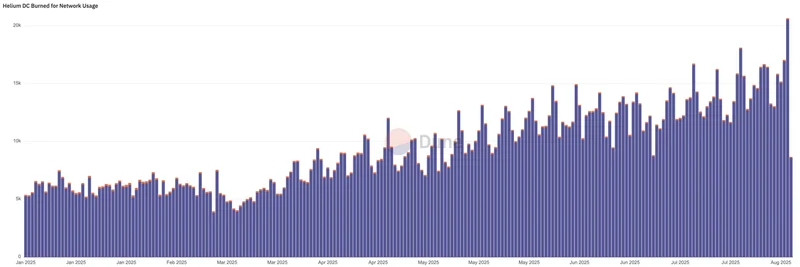Hey folks, if you're into the world of decentralized networks and crypto tokens, you've probably heard of Helium. It's that blockchain project where people set up hotspots to provide wireless coverage and earn HNT tokens in return. Well, things just got exciting—Tushar Jain, co-founder of Multicoin Capital, dropped a tweet highlighting a major milestone for the Helium Network.
In his post on X (formerly Twitter), Tushar shared that yesterday marked the network's first day generating $20,000 in revenue. And get this: every bit of that revenue directly burns HNT tokens. Burning tokens means they're removed from circulation, which can help reduce supply and potentially boost the value for holders over time. It's like a built-in deflationary mechanism tied straight to real-world usage.
He also included a chart showing the long-term revenue trend, which illustrates steady, compounding growth. This isn't just hype; it's data-backed progress as Helium taps into the massive market for mobile data—a space projected to reach hundreds of billions of dollars with endless demand.
What Does This Mean for Helium and HNT?
For those new to Helium, it's part of the DePIN (Decentralized Physical Infrastructure Networks) sector. Users deploy hardware like hotspots or mobile radios to build out a community-owned wireless network. In return, they earn HNT, the native token. The revenue Tushar mentioned comes from Data Credits (DC), which are used to pay for network usage—think IoT devices sending data or mobile phones roaming on Helium's 5G coverage.
When DCs are spent, they're burned, and since DCs are bought with HNT, this creates a direct link between network activity and token burns. Hitting $20K in a single day is a big deal because it shows real adoption. The chart reveals a clear upward trajectory: starting low in early 2025 and ramping up significantly by mid-year, with peaks pushing toward that 20K mark.
This growth aligns with Helium's expansion into mobile services. They've partnered with carriers and are building out decentralized 5G networks, which could disrupt traditional telecom giants. As more devices connect—scooters, trackers, phones—the demand for Helium's coverage skyrockets, leading to more burns and potentially higher HNT value.
Why Should Meme Token Enthusiasts Care?
At Meme Insider, we usually dive deep into meme coins, but Helium's HNT has that community-driven vibe that echoes the best memes. It's not just speculation; it's utility-backed with a tokenomics model that rewards participation. If you're holding or farming meme tokens, keep an eye on projects like Helium that blend real-world impact with crypto economics. This milestone could inspire similar burn mechanisms in meme ecosystems, making them more sustainable.
Looking Ahead
Tushar nailed it when he said Helium is growing into a multi-hundred-billion-dollar market. With insatiable demand for mobile data—fueled by everything from autonomous vehicles to smart cities—the network's compounding growth suggests we're just scratching the surface. If you're a blockchain practitioner, this is a prime example of how DePIN projects can scale and create value.
For more on Helium, check out their official site here. And if you want to see the original tweet, head over to Tushar Jain's post on X.
Stay tuned to Meme Insider for the latest on meme tokens, blockchain news, and ways to level up your crypto knowledge. What's your take on Helium's rise? Drop a comment below!


